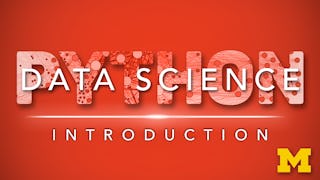This course will teach you how to leverage the power of Python and artificial intelligence to create and test hypothesis. We'll start for the ground up, learning some basic Python for data science before diving into some of its richer applications to test our created hypothesis. We'll learn some of the most important libraries for exploratory data analysis (EDA) and machine learning such as Numpy, Pandas, and Sci-kit learn. After learning some of the theory (and math) behind linear regression, we'll go through and full pipeline of reading data, cleaning it, and applying a regression model to estimate the progression of diabetes. By the end of the course, you'll apply a classification model to predict the presence/absence of heart disease from a patient's health data.

Enjoy unlimited growth with a year of Coursera Plus for $199 (regularly $399). Save now.

Introduction to Data Science and scikit-learn in Python
This course is part of AI for Scientific Research Specialization



Instructors: Sabrina Moore
8,452 already enrolled
Included with
(52 reviews)
Recommended experience
What you'll learn
Employ artificial intelligence techniques to test hypothesis in Python
Apply a machine learning model combining Numpy, Pandas, and Scikit-Learn
Skills you'll gain
- Python Programming
- Predictive Modeling
- Statistical Methods
- Machine Learning Algorithms
- Statistical Hypothesis Testing
- Data Preprocessing
- Regression Analysis
- Exploratory Data Analysis
- Classification Algorithms
- Data Science
- Data Manipulation
- Feature Engineering
- Data Analysis
- Data Structures
- Machine Learning
- Scikit Learn (Machine Learning Library)
- NumPy
- Supervised Learning
- Pandas (Python Package)
Details to know

Add to your LinkedIn profile
9 assignments
See how employees at top companies are mastering in-demand skills

Build your subject-matter expertise
- Learn new concepts from industry experts
- Gain a foundational understanding of a subject or tool
- Develop job-relevant skills with hands-on projects
- Earn a shareable career certificate

There are 4 modules in this course
In this module, we'll get ourselves started with Programming in Python. After becoming familiar with Python and the Jupyter Notebook interface, we'll dive into some basic coding paradigms such as variables, loops, and functions. We'll also cover data structures in the form of lists and dictionaries. We'll go through one of the most useful things in your Python arsenal - importing and using modules effectively. Finally, we'll introduce scikit-learn and walk through a classification problem to predict the presence/absence of cancer from health data.
What's included
9 videos5 readings2 assignments4 programming assignments1 discussion prompt5 ungraded labs
In this module, we'll become familiar with the two most important packages for data science: Numpy and Pandas. We'll begin by learning the differences between the two packages. Then, we'll get ourselves familiar with np arrays and their functionalities. Adding text turns our arrays into tables, and gives rise to the Pandas module. After a basic introduction, we'll end with a series of important data manipulation tools such as indexing, merging/combining datasets, and reshaping data.
What's included
8 videos5 readings4 assignments1 programming assignment1 discussion prompt2 ungraded labs
In this module, we'll work from the ground up to build and test our hypothesis. Learning both the theory and the code, we'll learn to test our predictions with different types of machine learning algorithms. We'll start by going through some of the necessary data preprocessing steps to orient ourselves. Getting familiar with using the Scikit-Learn library starts with the documentation. From there, we'll load in a dataset and analyze some of its most basic properties. Finally, we'll import and use models to make a prediction.
What's included
6 videos3 readings3 assignments1 programming assignment1 discussion prompt1 ungraded lab
In the final project, we'll try and predict the presence of heart disease using patient data. We'll load in data, create new features, and apply a machine learning algorithm using scikit-learn.
What's included
1 video1 programming assignment1 ungraded lab
Earn a career certificate
Add this credential to your LinkedIn profile, resume, or CV. Share it on social media and in your performance review.
Offered by
Explore more from Data Analysis
 Status: Free Trial
Status: Free TrialUniversity of Michigan
 Status: Free Trial
Status: Free Trial Status: Free Trial
Status: Free TrialGoogle
Why people choose Coursera for their career




Learner reviews
52 reviews
- 5 stars
46.15%
- 4 stars
15.38%
- 3 stars
13.46%
- 2 stars
9.61%
- 1 star
15.38%
Showing 3 of 52
Reviewed on Jan 30, 2022
It could be better if we can see where we did wrong after each assignment. Good and well-paced course otherwise
Reviewed on Nov 27, 2021
Good introduction. A bit too short for a 4-week course. The autograder is not very good, and some solutions are wrong.
Reviewed on Apr 4, 2022
The topic is great, and the linkage and references provided are valuable.The hands-on quiz should be supported with better instructions and descriptions regarding what to do.
Frequently asked questions
To access the course materials, assignments and to earn a Certificate, you will need to purchase the Certificate experience when you enroll in a course. You can try a Free Trial instead, or apply for Financial Aid. The course may offer 'Full Course, No Certificate' instead. This option lets you see all course materials, submit required assessments, and get a final grade. This also means that you will not be able to purchase a Certificate experience.
When you enroll in the course, you get access to all of the courses in the Specialization, and you earn a certificate when you complete the work. Your electronic Certificate will be added to your Accomplishments page - from there, you can print your Certificate or add it to your LinkedIn profile.
Yes. In select learning programs, you can apply for financial aid or a scholarship if you can’t afford the enrollment fee. If fin aid or scholarship is available for your learning program selection, you’ll find a link to apply on the description page.
More questions
Financial aid available,






